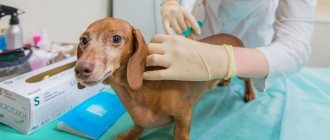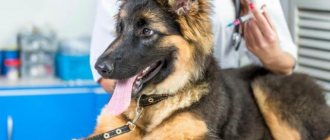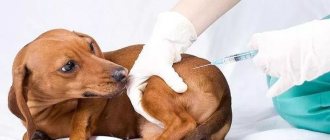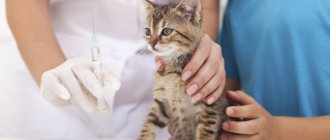In modern society there are many contradictions about vaccinations, both in humane medicine and in veterinary medicine. Some people consider vaccinations a “great conspiracy,” while others consider them a necessary measure for a normal existence.
We, as qualified veterinarians, are confident that vaccinations are a mandatory procedure for both humans and animals, preventing the most dangerous diseases.
In this article we will look in detail at why vaccinations for dogs are needed, what a vaccine is and how it works. And also, at what age to place and how to prepare the pet.
What is a vaccine, how does it work and why is it needed?
Often, owners vaccinate their pets without thinking about what the vaccine consists of and how it works. Although understanding the whole process is not only interesting, but also necessary for preparing your pet for vaccination and further caring for it.
A vaccine is a biological product designed to create and maintain active immunity against certain infectious diseases.
In other words, this drug contains either live, weakened pathogens or killed ones. Based on this, vaccines are divided into groups.
Live vaccines
They consist of living but weakened strains of pathogens. Such biological products are not capable of causing disease, but are capable of inducing an immune response in the body.
Advantages of live vaccines:
- creation of long-lasting and intense immunity (more than 1 year, sometimes a lifetime);
- in most cases, single administration, small dose;
- immunity is developed in a short time;
- the production technology is cheaper than that of inactivated ones.
Disadvantages of live vaccines:
- post-vaccination complications in pregnant bitches and weakened dogs;
- reversion (return of the strain to its original virulent form);
- features in transportation and storage;
- duration of receiving the attenuated (weakened) vaccine.
Inactivated vaccines
Biological products based on a completely killed strain of the virus.
Advantages of inactivated vaccine:
- does not cause complications after vaccination;
- immunity is less tense;
- ease of production and relatively low cost.
Disadvantages of inactivated vaccine:
- low immunogenicity;
- need for 3-4 times application, large volume;
- immunity, compared to a live vaccine, does not last long;
- increased likelihood of allergic reactions.
Difference in vaccines by number of strains
- Monovalent - against one strain of pathogen.
- Polyvalent - against several strains of one pathogen.
- Associated (combined) – against several pathogens.
Most often, associated live vaccines are used in practice.
Forms of rabies in dogs
Veterinary medicine distinguishes three main forms on which the clinical picture of the disease depends:
- Violent.
- Quiet (paralytic).
- Atypical.
Violent
On average, it lasts from 5 to 14 days and is divided into three stages, during which changes in the behavior of the animal are clearly expressed.
Stage 1 . The animal may exhibit atypical behavior that was previously unusual for this individual, for example, increased affection or passive aggression. Some apathy or anxiety appears. Appetite is reduced or distorted (the animal swallows inedible objects). The act of swallowing becomes difficult, vomiting, drooling and hallucinations appear.
Stage 2 . The animal shows pronounced aggression, anxiety increases greatly, there may be self-traumatization (biting its own body), the desire to run and gnaw on surrounding objects. At this stage, convulsive seizures also appear, which become more frequent and lengthen over time. Paresis of the tongue and larynx, initial paralysis of the facial muscles appear, due to which the voice becomes hoarse, muffled or disappears altogether (aphonia), the act of swallowing is disrupted, squint develops, the lower jaw droops, the tongue falls out of the mouth, and profuse and uncontrollable salivation appears. Taking food and water becomes impossible.
Stage 3, terminal - paralytic . The animal is usually severely emaciated. The gait becomes unsteady, then paralysis of the hind limbs, atony of the intestines and bladder develops. This is followed by tetraplegia (paralysis of all limbs), the animal falls into a soporous state and coma. Death occurs from respiratory arrest due to paralysis of the respiratory muscles.
Important! This is the most common form of rabies not only in dogs, but also in other animals.
Silent (paralytic)
On average, it lasts 2-4 days. Characterized by the development of paralysis, drooling, and inability to eat. There are no sudden changes in behavior, including no aggressiveness.
Atypical
The most difficult form to diagnose can last up to 3 months. There are no typical symptoms of the disease. Initially, it may manifest itself as diarrhea or, conversely, intestinal atony and depression of consciousness. During the course of the disease, temporary improvements may occur, but in the end the animal still dies with rapidly increasing neurological symptoms.
Important! Furious rabies is the most common form of rabies not only in dogs, but also in other animals.
Along with these forms, there are others. They are not so common and in the entire history of studying the disease they have been encountered only in isolated cases. These forms include:
- Returnable (remittive).
It is characterized by the fact that the signs of rabies in a dog go away, but return again. It seems that the pet has recovered, but this is not the case - and after a few days its condition worsens again. Typically, with the recurrent form, 2-3 such alternations are observed.
- Abortive.
The main feature of this form is that after the first stage the disease suddenly stops and the dog makes a full recovery. This behavior of the organism is practically not studied. The abortive form occurs in only 1-2% of infected pets.
How do vaccines work?
The effect of the vaccine is reduced to the creation of an antigen-antibody complex. Simply put, it contains a weakened microorganism - this is an antigen; once it enters the body, it causes an immune response that identifies the foreign agent and produces antibodies - T-lymphocytes - to eliminate it.
T-lymphocytes (memory cells) remember the “way to fight” the virus, which will further shorten the identification of the antigen and speed up the fight against it.
When a biological product is administered, the body independently produces an immune response, thereby providing long-lasting immunity.
Characteristics and danger of rabies
The causative agent of rabies is the rhabdovirus family, which affects the central nervous system. As a result of infection, the animal experiences damage to the nerve endings and gradual failure of the spinal cord and brain.
The main symptoms of this dangerous disease include the following:
- hydrophobia (refusal to drink, uncontrollable fear at the sound of dripping water);
- aggressive or apathetic behavior;
- copious foamy saliva caused by a violation of the swallowing reflex;
- perverted appetite (eating inedible objects).
A sick dog must be isolated in a separate room and not contacted until the veterinarian arrives. The virus is equally dangerous for all warm-blooded animals, including humans. In the final stage, it causes laryngeal paralysis or cardiac arrest.
In the absence of vaccination and the appearance of at least one of the listed symptoms, the chances of salvation are close to zero. Due to the lack of a cure, the only humane solution is euthanasia.
Why is vaccination necessary?
A dog, unlike a cat, is constantly in contact with the environment, with other dogs, this is associated with walks. It is during this time spent on the street that a dog can “catch” a dangerous virus, which will lead not only to illness, but also to death.
It is important to remember that an unvaccinated dog potentially poses a danger to humans, since a large number of diseases are transmitted from animals to humans, for example, the incurable disease rabies.
A vaccinated pet has immunity, which means it cannot become infected or infect others.
How the disease manifests itself in dogs - the main signs
The first thing you need to pay attention to is changes in your pet's behavior. At first the dog begins to be afraid of water and light. She can fawn over people, including strangers, and ask for attention.
A few days later, the situation changes dramatically - the animal behaves very aggressively, breaks loose from its leash, rushes for no reason, and can bite (and this is a very dangerous period for humans, because they can also become infected!).
A dog with rabies can run a very long distance. She attacks other animals and people. At the same time, attacks of aggression and violent behavior are replaced by periods of complete rest.
The main signs indicating the development of rabies in a dog:
- lack of a swallowing reflex - saliva flows from the animal’s mouth (possibly in the form of foam),
- hard breath,
- loss of appetite,
- swallowing inedible objects,
- bouts of vomiting,
- hoarse barking,
- unsteady gait
- paralysis of the lower jaw and larynx - the animal cannot lap up water,
- paralysis of the hind limbs.
What vaccinations should a dog have?
Vaccinations must be given to both puppies from 1 month to a year and adult dogs. And when and what to give, in the table of vaccinations for dogs by age:
| Name of the disease | 1st vaccination | 2nd vaccination | Revaccination | Subsequent vaccination | Method of administration |
| Rabies | 12-13 weeks | — | At 1 year | Annually | s/c, i/m |
| Carnivore plague | 8-10 week | In 2-4 weeks | At 1 year | Annually | s/c, i/m |
| Infectious (viral) hepatitis | 8-10 week | In 3-4 weeks | At 1 year | Annually | s/c, i/m |
| Parvovirus enteritis. Coronavirus enteritis | 8-10 week | In 3-4 weeks | At 1 year | Annually | s/c, i/m |
| Canine parainfluenza | 8-10 week | In 3-4 weeks | At 1 year | Annually | s/c, i/m |
| Leptospirosis | 8-10 week | In 3-4 weeks | At 1 year | Annually | i/m |
| Trichophytosis, microsporia (ringworm) | 1-6 months | After 10-14 days | At 1 year | Annually | i/m |
A frequent question asked to a veterinarian is why they vaccinate against these diseases, why they are dangerous, and what else a dog can be vaccinated against. Let's figure it out.
Rabies (rabies, hydrophobia)
A dangerous incurable infectious disease that is transmitted from a sick animal to a healthy one or person.
It is a natural focal disease. It is transmitted through the saliva of an infected person through direct contact or through care items and clothing.
Symptoms: excessive drooling, unreasonable aggression, paralysis of the mouth muscles, fear of water (hydrophobia) and air currents (aerophobia).
Vaccination against piroplasmosis is in fact ineffective, since ticks adapt, after several generations, to the vaccine.
Plague (plague)
A disease of carnivores, usually characterized by damage to the nervous system.
A person does not suffer from plague, but is a carrier on clothing. The mortality rate of puppies 2 - 3 months old reaches 40 - 100%.
Symptoms: fever, redness of mucous membranes, damage to the skin and central nervous system, periodic convulsions.
Infectious hepatitis
A contagious viral disease that affects a wide group of carnivores.
Infection of people has not been recorded; mainly puppies under one year of age and old weakened organisms are affected.
Symptoms: fever, shortness of breath and rapid breathing, tachycardia, muscle cramps, liver enlargement, gastrointestinal upset.
Enteritis
Inflammation of the small intestine. Not dangerous for humans. There are two varieties:
- parvovirus enteritis;
- coronavirus enteritis.
Symptoms: diarrhea, fever, vomiting, dehydration, etc.
There is no vaccine against ticks! You should not vaccinate your dog after a tick bite, because Perhaps the tick does not carry any disease, you should contact the clinic to check the animal’s condition.
Canine parainfluenza
A disease caused by viruses that affects the upper respiratory tract. More common in group housing, mortality is low.
Symptoms: kennel cough, nasal discharge, inflammation of the tonsils.
Leptospirosis
A disease caused by an infectious type that is dangerous to humans.
Symptoms: fever, anemia, damage to parenchymal organs, hemorrhages on the mucous membranes of the mouth and gastrointestinal tract.
According to common misconceptions, there are no vaccines against ticks/fleas/endoparasites.
Complications after vaccinations
Over the next two days after immunization, the dog’s body develops immunity to viruses.
- At this moment, the pet may be a little depressed and refuse food. There is no need to be afraid of this, everything should go away within the next 48 to 72 hours . Otherwise, you will have to contact the clinic again.
- Allergic reactions to vaccinations are possible in theory, but in practice such cases are extremely rare. Despite this, many modern veterinary institutions value their reputation and give an injection of an antihistamine before administering antiviral serum.
If your pet begins to experience allergic reactions after the vaccine (swelling, itching, redness and discharge from the mucous membranes), you need to seek help from the doctor who administered the injection. And at the next immunization, use a different serum.
Thanks to an increase in the level of canine literacy of the population and a breakthrough in veterinary medicine. Over the past two decades, it has been possible to reduce the mortality rate of animals under 3 months of age by almost 3 times. It was possible to reduce rabies epidemics in populated areas by 5 times. This is how many lives are saved thanks to a simple injection in the withers.
3.7 / 5 ( 3 voices)
Vaccines and serums for dogs
It's no secret that medicine does not stand still and constantly pleases us and our pets with new drugs, and vaccines are no exception. New biological products are being developed and old ones are being improved. Let's look at the most popular vaccines in veterinary medicine.
Biovac - prevents from: plague, infectious hepatitis, adenovirosis, parvovirus enteritis, leptospirosis. Country of issue: Russia.
| Disease | BIOVAC-R | BIO-VAK-RA | BIO-BAK-PAL | BIOVAK-L |
| Parvovirus enteritis | + | + | + | — |
| Adenoviral infections | — | + | + | — |
| Leptospirosis | — | — | + | + |
Canigen DHA2PPi/L - prevents from: plague, infectious hepatitis, adenoviral infection, parainfluenza, parvovirus enteritis, leptospirosis. Country of issue: France.
Nobivak. Country of issue: the Netherlands.
| Disease | Nobivac DHP | Nobivac DHPPi | Nobivac Lepto | Nobivak Puppy | Nobivac Rabies |
| Plague | + | + | — | + | — |
| Infectious hepatitis | + | — | — | — | — |
| Parvovirus infection (enteritis) | + | + | — | + | — |
| Adenovirus | — | + | — | — | — |
| Parainfluenza | — | + | — | — | — |
| Leptospirosis | — | — | + | — | — |
| Rabies | — | — | — | — | + |
Eurican DHPPI2-L - plague, adenovirus, parainfluenza, leptospirosis. Eurikan DHPPI2-LR - DHPPI2-L + rabies. Country of issue: France.
Vanguard 5/L and 7 – prevention of plague, parvovirus enteritis, infectious hepatitis, parainfluenza, adenoviral respiratory infection and leptospirosis. Country of issue: Slovenia.
Multikan. Country of issue: Russia.
| Disease | Multikan -1 | Multikan - 2 | Multikan -4 | Multikan – 6 | Multikan - 7 | Multikan - 8 |
| Plague | + | — | + | + | + | + |
| Adenoviral infections | — | + | + | + | + | + |
| Coronavirus enteritis | — | — | + | + | + | + |
| Parvovirus enteritis | — | + | + | + | + | + |
| Leptospirosis | — | — | — | + | — | + |
| Rabies | — | — | — | — | — | + |
| Dermatophysis | — | — | — | — | + | — |
When traveling outside the Russian Federation, a passport with imported vaccinations is required.
Vaccination table for puppies in their first year of life
The table below will help you figure out what vaccinations puppies receive:
| Dog age | What is the vaccine for? | Notes |
| 1 month | Vaccination series PUPPY | Do as needed |
| 8-10 weeks | From plague, enteritis, hepatitis, parainfluenza, leptospirosis | Primary vaccination |
| 11-13 weeks | From plague, parainfluenza, hepatitis, enteritis, leptospirosis | Revaccination |
| 11-13 weeks | For rabies | Primary vaccination |
| 6-7 months | From plague, parainfluenza, plague, enteritis, hepatitis, leptospirosis | Repeated vaccination |
| 6-7 months | For rabies | Repeated vaccination, then after a year |
| 1 year | From plague, parainfluenza, hepatitis, leptospirosis, enteritis | Repeated vaccination, then after a year |
Contraindications and possible complications
Due to the invasion of the immune system by foreign agents, the body may exhibit severe “restlessness.” After vaccination, the dog may feel nauseous/vomit, the animal has a decreased appetite, slight fluctuations in body temperature, it is lethargic and trembling.
This is a normal reaction of the body, so there is no reason to worry. If the above symptoms do not stop after a long time and new ones appear, consult a doctor.
Also, a common complaint from owners after vaccination is the presence of a lump on the dog at the injection site - this is due to a violation of the injection technique; after 3-4 days it resolves on its own.
The question that concerns breeders is whether vaccination during estrus is possible or not? We answer - it is possible, but it is not recommended, it is better to wait.
Conditions for preparing for vaccination
Before you vaccinate your dog, it needs to be prepared for it. The main condition for successful vaccination is the absolute health of the pet. Therefore, a medical examination is required before vaccination. If the animal is unwell or weakened due to childbirth, surgery, or injury, then the vaccination dates will be postponed. It is equally important to observe the following points before vaccination:
- A week before vaccination, your pet must be rid of all parasites - fleas, ticks, and especially worms. The presence of parasites or poor health significantly weakens the dog’s immune system, so the vaccine may simply “not work.” You can deworm your dog with drugs such as Drontal, Dekaris or Vermox; the dose is calculated depending on the weight of the animal. If there are other dogs at home, then for prevention purposes they are dewormed too;
- Puppies should not be walked before their first vaccination. But if you can’t wait to do this, then you can take him outside for a while in your arms, but in no case lower him to the ground;
- If digestive disorders appear, or the dog looks lethargic and cheerless, refuses to eat, then before vaccination, you must inform your doctor about this. It is also necessary to warn if the dog is prone to allergies.
Pregnant bitches are vaccinated with caution, as there is an opinion that live strains of viruses can penetrate the placenta and negatively affect the embryos. But vaccines with killed pathogens have been tested and can be used if there is an urgent need. Estrus is not a contraindication to vaccination, since it is a physiological process.
How to prepare your dog for vaccination
Vaccination is a rather serious procedure for which you should prepare. To do this you need:
- 2-3 weeks before the scheduled date, carry out deworming;
- “forget” about walks to avoid contact with any dogs;
- 5 – 7 days before the visit to the doctor, monitor the condition of the four-legged animal;
- do not feed the dog before vaccination (3.5 – 4 hours);
- if the pet is afraid, it is better to be nearby, pet it and talk to it.
Deworming – treatment against internal parasites. They give deworming tablets, which can be purchased at a veterinary pharmacy. The body must be completely “cleansed” of worms and other parasites.
Cost of the procedure
Vaccination prices vary depending on:
- Manufacturer of the drug.
- Spectrum of diseases covered.
- The level of service of the clinic.
- Where is the serum applied (going to the client’s home is more expensive than on site).
- Region of residence.
- Degree of competition among clinics.
- Veterinarian qualifications.
The average price for comprehensive vaccination ranges from 500 to 1000 rubles at a veterinary institution. With a home visit, depending on the client’s location, from 1000 to 2000 rubles .
What to do after vaccination
After the four-legged animal has been vaccinated, quarantine is required for up to 2 weeks. Basic rules:
- complete lack of communication with other relatives;
- the diet must contain the required amount of proteins, fats, carbohydrates and vitamins;
- calm and quiet environment, comfortable living conditions (no drafts, hypothermia/overheating, etc.);
- refrain from any bathing, do not wash your pet or wet the injection site for 3–4 days;
- play and run as little as possible, avoid excessive activity.
Features of vaccination depending on breed
Breed does not affect the vaccination order. The dosage of the drug is standard for all breeds. Increasing or decreasing the recommended dose may result in a lack of effect or the development of complications.
Exceptions include breeds at risk. But even in this case, all changes are discussed with the veterinarian.
FAQ
Is a dog's rabies vaccination required or not? How long does it last?
Vaccination is mandatory, the animal can be vaccinated with a domestic vaccine in a state veterinary clinic completely free of charge. This vaccination is valid for 1 year.
Is it possible to get vaccinated at home?
It is possible, but it is strongly not recommended; if you have no experience in this matter, it is better to contact a specialist.
My dog is a month overdue for vaccinations, what should I do?
Vaccination is not only possible, but also necessary in a month or even later, at any time. Even if this is an adult dog that has never been vaccinated, vaccinations are given as for a puppy, only with slightly modified dates.
Why do you need a rabies vaccination?
Rabies is dangerous not only for dogs, but also for humans. Unfortunately, a sick animal is completely uncontrollable. This is no longer your affectionate and devoted dog, but only an aggressive dog that has lost its instinct of self-preservation. Neither attempts to stop her nor physical influence will help.
Vaccinating your dog against rabies is mandatory. Information that the animal is vaccinated and safe for others may be required when transporting or crossing the border, as well as in the event of an attack on another animal or person.
Briefly about the main thing
- Vaccinations are a mandatory annual procedure to prevent dangerous infectious diseases.
- It is necessary to vaccinate according to schedule for the drug to be effective.
- A deadly, zoonotic disease on the territory of the Russian Federation is rabies.
- It is better to use an associated vaccine to prevent a number of dangerous diseases
- Weakness and malaise after vaccination are a normal state of any living organism.
- Vaccination against rabies is mandatory and is carried out free of charge in state veterinary clinics.
Validity period and frequency of revaccination
Please note that the validity period and frequency of revaccination depends on the specific type of vaccine and this should be found out either from a veterinarian or by reading the instructions for the drug. But the general recommendations of veterinary immunologists are as follows:
- Most modern rabies vaccines last from two to three years. The manufacturer guarantees that at this time there will be antibodies to the rabies virus in the animal’s blood.
- But! At the same time, in most countries the requirement for mandatory annual revaccination is enshrined at the legislative level. The duration of the vaccine does not matter at all.
Moreover, in regions where the situation with rabies is extremely unfavorable, the decision to revaccinate the animal is made based on determining the antibody titer. If the rates are low, then the dog can be re-vaccinated several months after the first vaccination.
Is it possible to vaccinate pregnant and lactating dogs?
According to the rules, the procedure should take place no later than 2 weeks before mating, so that the dog can be prepared and not worry about it getting sick during pregnancy. In addition, puppies will receive maximum immune protection through the placenta and then through the milk.
A dog can be vaccinated in the first third of pregnancy (first 20 days) only with Nobivak or Eurikan vaccines. But she will no longer protect the puppies. If vaccination was not possible. You will have to wait until your pet gives birth and gets stronger, and then vaccinate her along with the babies.
The breeder often gives the first vaccination to puppies and the future owner does not have to choose a brand of vaccine, he repeats the same one according to the schedule
Where can you get vaccinated with Prevenar?
You can administer the Prevenar vaccine at our medical center in Mytishchi. We work only with original drugs that have all the necessary certificates. The procedure is carried out by qualified doctors in a specially equipped room. We can also create an individual vaccination schedule for you and your children. Our specialists will perform a preventive examination to identify contraindications, answer any questions you may have, and tell you how to prepare for the procedure. You can sign up for a consultation through the website or by calling the numbers listed in the appropriate section.
conclusions
Vaccinations are very important for health and should not be neglected. Their choice is wide and depends on the area, the threat of various diseases, the availability of finances and the profile of the vaccination carried out. All manufacturers have their pros and cons. The animal's vaccination schedule depends on the age and type of vaccine.
Please follow and like us:
Nikitin Sergey
I write about dogs based on the experience and knowledge gained during my studies as a veterinarian, work in my specialty, and simply from observing my pets.
Why do you need a veterinary passport?
This is a small book that is sold in many veterinary pharmacies/clinics. Costs about 50 rubles. Data about the dog and all veterinary preventive measures are entered here: treatment, operations, vaccinations, treatments for parasites, etc.
Each vaccine has a label with an individual serial number and release date. It is pasted into the appropriate box in the passport. The doctor’s signature is placed next to it and all this is supported by his personal seal or the seal of the clinic. This is proof that the procedure was carried out, as well as a “reminder” of when to do the next one and which one.
A veterinary passport without stamps is not a document and cannot be presented at exhibitions, when moving, flying, or in the event of a dog bite (if it is necessary to prove that it does not have rabies).
Vaccination will help protect your pet from dangerous infectious diseases.











